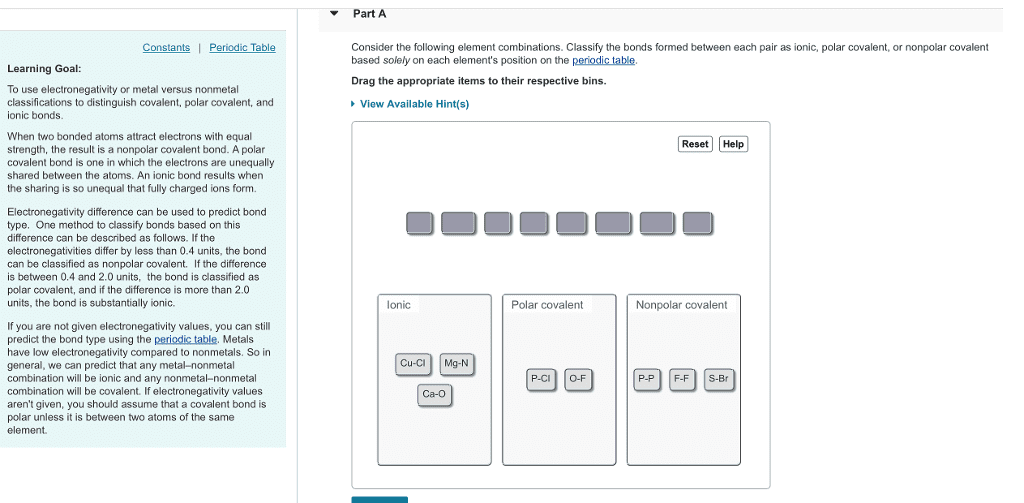CHEM 1500 Lecture Notes - Lecture 11: Ionic Bonding, Chemical Formula, Ionic Compound

L11: CHEMICAL COMPOUNDS (PART 1)
CHEMICAL COMPOUNDS
Chemical compounds: are composed of 2 or more elements and are held together by chemical bonds.
REMEMBER:
METALS have a tendency to LOSE electrons and become CATIONS
NONMETALS have a tendency to GAIN electrons and become ANIONS
Electrostatic Forces: forces that exist between charged particles: like charges repel one another and
opposite charges attract one another. These electrostatic charges are responsible for chemical bonding.
There are two types of chemical compounds: molecular compounds and ionic compounds
Molecular Compounds
Ionic Compounds
usually composed of two or more covalently bonded
nonmetals
nonmetals
Made of ions (metal cations and nonmetal anions)
which are held together by ionic bonds.
metals + nonmetals
Covalent Bonds:
- occur between two or more nonmetals
- involve the sharing of electrons between
two atoms
- very strong bonds
Ionic Bonds:
- occur between metal and nonmetal ions
- involve the transfer of electrons from one
atom to another
- are not as strong as covalent bonds
- these bonds are held together by
electrostatic forces between ions formed as a
result of the transfer of electrons
How a covalent bond is formed:
When a nonmetal reacts with another nonmetal
(Nonmetals usually gain electrons, so neither atom
will transfer electrons to the other, instead the
bonding atoms will share some of their electrons)
1) When both atoms need a certain number of
electrons to achieve a full valence shell
2) They will pair up and share electron pairs
3) The shared electron pair is what keeps the two
atoms close together and is called a covalent bond
How an ionic bond is formed:
When a metal interacts with a nonmetal.
(Metals lose electrons and nonmetals gain electrons)
1) The metal atom can transfer electron(s) to the
nonmetal atom
2) The metal becomes a cation (+) and the nonmetal
becomes an anion (-)
3) Since the two ions now have opposite charges,
they are attracted to one another by electrostatic
forces and they form an ionic bond
Strength of Attraction of a Covalent Bond
- vary hard to break
- can only be broken by a chemical change
- upon physical changes atoms will remain bonded in
a molecule (because molecules will stick together
regardless of whether they are a gas, liquid, or solid)
Strength of Attraction of an Ionic Bond
- since they’re held together by electrostatic attraction
- relatively easy to break
- can be broken with a physical change: the crystal
may break down to ions, and or “release ions”

CHEMICAL FORMULAS
Chemical compounds are represented by chemical formulas
Chemical Formula: indicates the elements present in the compound and the relative number of atoms or ions
for each element.
CHEMICAL FORMULAS
Molecular Compounds
The basic units of molecular compounds are
molecules composed of their constituent atoms.
Ionic Compounds
The basic unit of an ionic compound is the formula
unit.
Formula unit: the smallest, electrically neutral
collection of ions
Formula units are different from molecules in that
they do not exist in discrete entities, but rather as part
of a larger crystal.
Therefore, a molecular formula corresponds to the
basic unit of a molecular compound: a single
molecule.
Therefore, a formula for an ionic compound
corresponds to the basic unit of an ionic compound: a
formula unit.
Molecular Formulas consist of:
- molecular formula
- empirical formula
- structural formula
- condensed structural formula
- line-angle formula
FORMULAS FOR MOLECULAR COMPOUNDS
1) Molecular Formula
- is based on an actual molecule of a compound
- shows atoms present and the actual number of atoms present in the compound
2) Empirical Formula
- shows the atoms present
- indicates their simplest whole number ratio: when there is a 1 in the formula, the ratio is in simplest
terms
Writing an Empirical Formula
1) Write the number of atoms in the molecule
2) Write the number of atoms as a ratio
- If there is a 1 present in the ratio, and that is the smallest number, then that is the simplest whole-
number ratio
- if there is no 1 present in the ratio, divide all numbers by a common factor so that there is a 1 present
and that is the simples whole number ratio
3) Write the Empirical Formula
*Molecular and empirical formulas are related via the multiplying factor:
Molecular → Empirical = Divide by Multiplying Factor. Empirical → Molecular = Multiply by Multiplying Factor
Document Summary
Chemical compounds: are composed of 2 or more elements and are held together by chemical bonds. There are two types of chemical compounds: molecular compounds and ionic compounds. Metals have a tendency to lose electrons and become cations. Nonmetals have a tendency to gain electrons and become anions. These electrostatic charges are responsible for chemical bonding. Ionic compounds usually composed of two or more covalently bonded nonmetals nonmetals. Involve the sharing of electrons between two atoms. Can only be broken by a chemical change. Upon physical changes atoms will remain bonded in a molecule (because molecules will stick together regardless of whether they are a gas, liquid, or solid) Made of ions (metal cations and nonmetal anions) which are held together by ionic bonds. metals + nonmetals. Involve the transfer of electrons from one atom to another. Are not as strong as covalent bonds.




